English Literature: Exploring Themes, Authors, and Literary Movements
VerifiedAdded on 2020/04/15
|12
|2693
|209
Essay
AI Summary
This essay provides a comprehensive overview of English Literature, spanning from the Puritan era to modern poetry. It delves into key movements like the Protestant Reformation, Transcendentalism, and the Harlem Renaissance, examining their philosophical underpinnings and cultural impacts. The essay explores prominent authors such as Anne Bradstreet, Jonathan Edwards, Benjamin Franklin, Washington Irving, Edgar Allan Poe, Ralph Waldo Emerson, Walt Whitman, Emily Dickinson, Mark Twain, Ernest Hemingway, and William Faulkner, analyzing their major works and thematic concerns. It covers significant concepts like Deism, Romanticism, Realism, and Naturalism, providing insights into their characteristics and influence on literary styles. Furthermore, the essay discusses the tenets of various literary periods and the contributions of influential figures, offering a detailed analysis of the evolution and diversity within English Literature. This document is a helpful study tool for students seeking to understand the breadth and depth of English literary history.
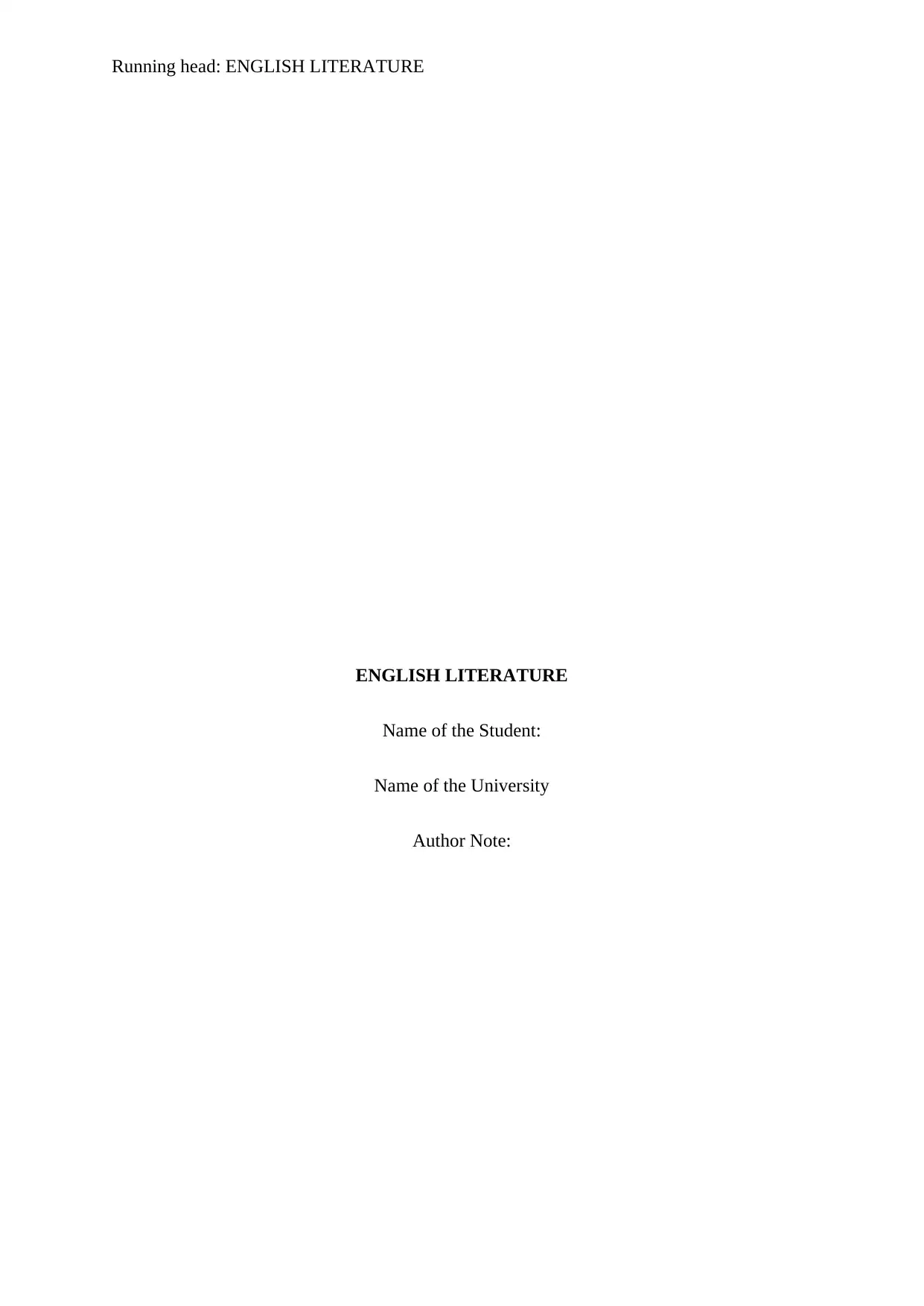
Running head: ENGLISH LITERATURE
ENGLISH LITERATURE
Name of the Student:
Name of the University
Author Note:
ENGLISH LITERATURE
Name of the Student:
Name of the University
Author Note:
Paraphrase This Document
Need a fresh take? Get an instant paraphrase of this document with our AI Paraphraser
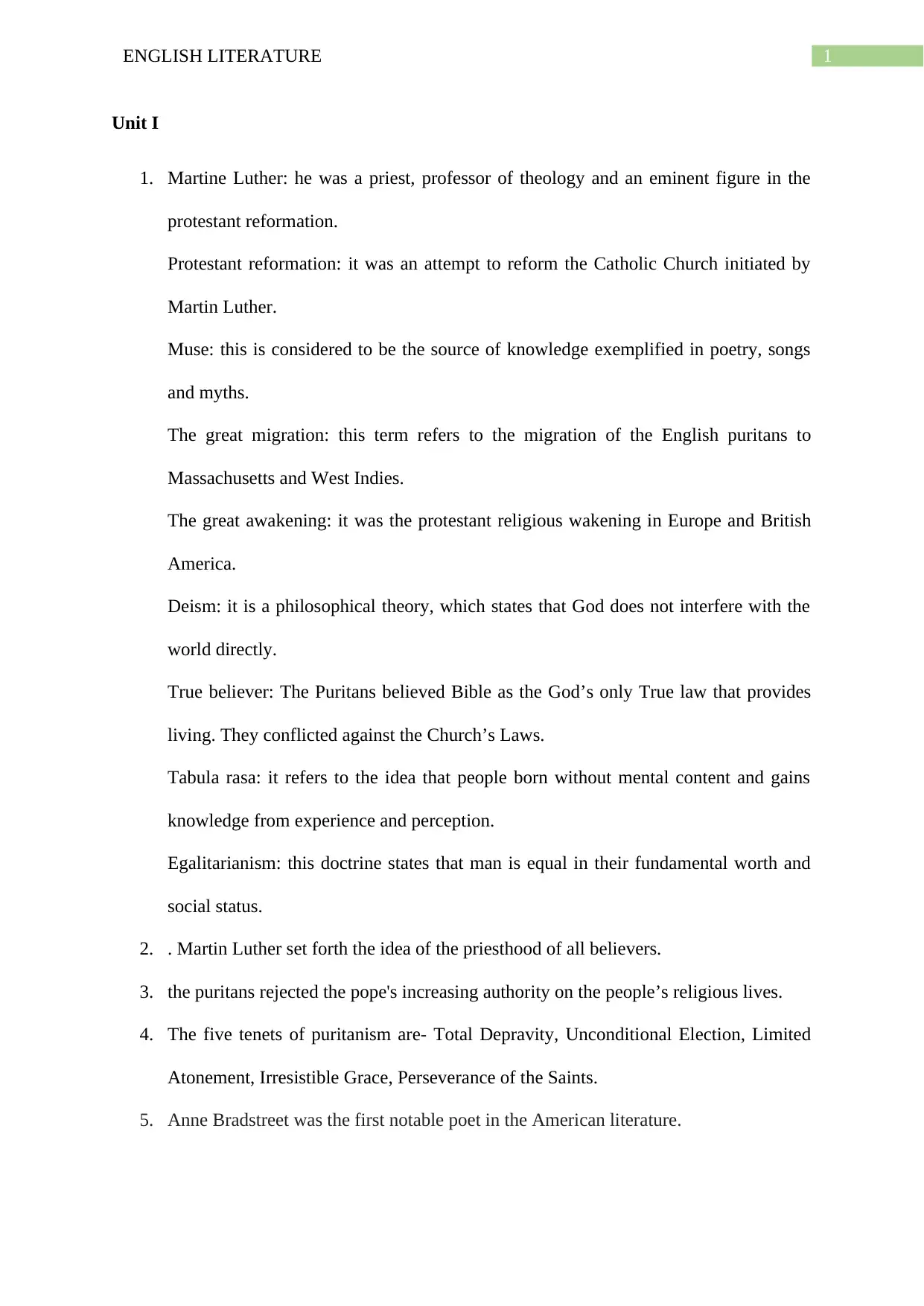
1ENGLISH LITERATURE
Unit I
1. Martine Luther: he was a priest, professor of theology and an eminent figure in the
protestant reformation.
Protestant reformation: it was an attempt to reform the Catholic Church initiated by
Martin Luther.
Muse: this is considered to be the source of knowledge exemplified in poetry, songs
and myths.
The great migration: this term refers to the migration of the English puritans to
Massachusetts and West Indies.
The great awakening: it was the protestant religious wakening in Europe and British
America.
Deism: it is a philosophical theory, which states that God does not interfere with the
world directly.
True believer: The Puritans believed Bible as the God’s only True law that provides
living. They conflicted against the Church’s Laws.
Tabula rasa: it refers to the idea that people born without mental content and gains
knowledge from experience and perception.
Egalitarianism: this doctrine states that man is equal in their fundamental worth and
social status.
2. . Martin Luther set forth the idea of the priesthood of all believers.
3. the puritans rejected the pope's increasing authority on the people’s religious lives.
4. The five tenets of puritanism are- Total Depravity, Unconditional Election, Limited
Atonement, Irresistible Grace, Perseverance of the Saints.
5. Anne Bradstreet was the first notable poet in the American literature.
Unit I
1. Martine Luther: he was a priest, professor of theology and an eminent figure in the
protestant reformation.
Protestant reformation: it was an attempt to reform the Catholic Church initiated by
Martin Luther.
Muse: this is considered to be the source of knowledge exemplified in poetry, songs
and myths.
The great migration: this term refers to the migration of the English puritans to
Massachusetts and West Indies.
The great awakening: it was the protestant religious wakening in Europe and British
America.
Deism: it is a philosophical theory, which states that God does not interfere with the
world directly.
True believer: The Puritans believed Bible as the God’s only True law that provides
living. They conflicted against the Church’s Laws.
Tabula rasa: it refers to the idea that people born without mental content and gains
knowledge from experience and perception.
Egalitarianism: this doctrine states that man is equal in their fundamental worth and
social status.
2. . Martin Luther set forth the idea of the priesthood of all believers.
3. the puritans rejected the pope's increasing authority on the people’s religious lives.
4. The five tenets of puritanism are- Total Depravity, Unconditional Election, Limited
Atonement, Irresistible Grace, Perseverance of the Saints.
5. Anne Bradstreet was the first notable poet in the American literature.
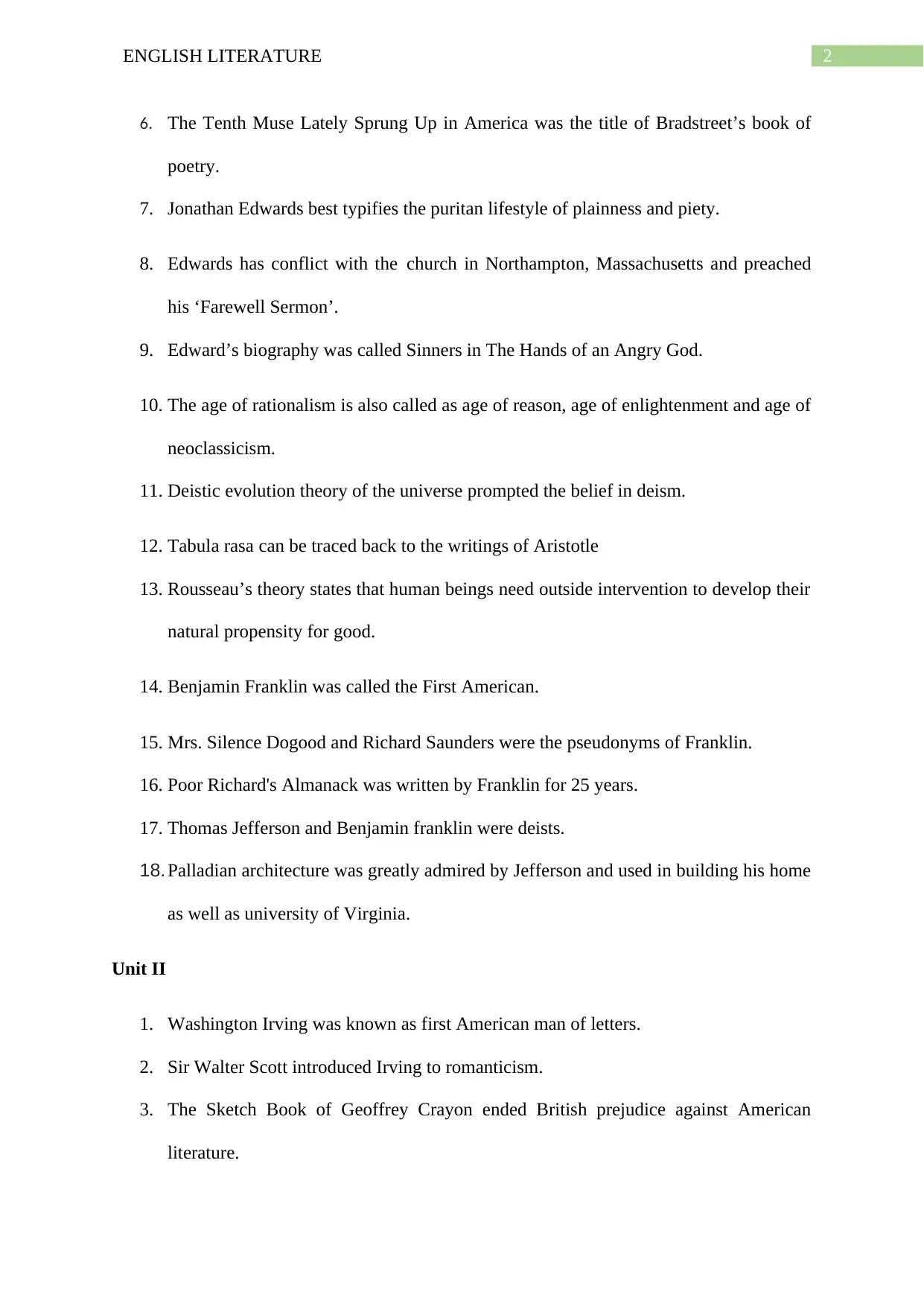
2ENGLISH LITERATURE
6. The Tenth Muse Lately Sprung Up in America was the title of Bradstreet’s book of
poetry.
7. Jonathan Edwards best typifies the puritan lifestyle of plainness and piety.
8. Edwards has conflict with the church in Northampton, Massachusetts and preached
his ‘Farewell Sermon’.
9. Edward’s biography was called Sinners in The Hands of an Angry God.
10. The age of rationalism is also called as age of reason, age of enlightenment and age of
neoclassicism.
11. Deistic evolution theory of the universe prompted the belief in deism.
12. Tabula rasa can be traced back to the writings of Aristotle
13. Rousseau’s theory states that human beings need outside intervention to develop their
natural propensity for good.
14. Benjamin Franklin was called the First American.
15. Mrs. Silence Dogood and Richard Saunders were the pseudonyms of Franklin.
16. Poor Richard's Almanack was written by Franklin for 25 years.
17. Thomas Jefferson and Benjamin franklin were deists.
18. Palladian architecture was greatly admired by Jefferson and used in building his home
as well as university of Virginia.
Unit II
1. Washington Irving was known as first American man of letters.
2. Sir Walter Scott introduced Irving to romanticism.
3. The Sketch Book of Geoffrey Crayon ended British prejudice against American
literature.
6. The Tenth Muse Lately Sprung Up in America was the title of Bradstreet’s book of
poetry.
7. Jonathan Edwards best typifies the puritan lifestyle of plainness and piety.
8. Edwards has conflict with the church in Northampton, Massachusetts and preached
his ‘Farewell Sermon’.
9. Edward’s biography was called Sinners in The Hands of an Angry God.
10. The age of rationalism is also called as age of reason, age of enlightenment and age of
neoclassicism.
11. Deistic evolution theory of the universe prompted the belief in deism.
12. Tabula rasa can be traced back to the writings of Aristotle
13. Rousseau’s theory states that human beings need outside intervention to develop their
natural propensity for good.
14. Benjamin Franklin was called the First American.
15. Mrs. Silence Dogood and Richard Saunders were the pseudonyms of Franklin.
16. Poor Richard's Almanack was written by Franklin for 25 years.
17. Thomas Jefferson and Benjamin franklin were deists.
18. Palladian architecture was greatly admired by Jefferson and used in building his home
as well as university of Virginia.
Unit II
1. Washington Irving was known as first American man of letters.
2. Sir Walter Scott introduced Irving to romanticism.
3. The Sketch Book of Geoffrey Crayon ended British prejudice against American
literature.
⊘ This is a preview!⊘
Do you want full access?
Subscribe today to unlock all pages.

Trusted by 1+ million students worldwide
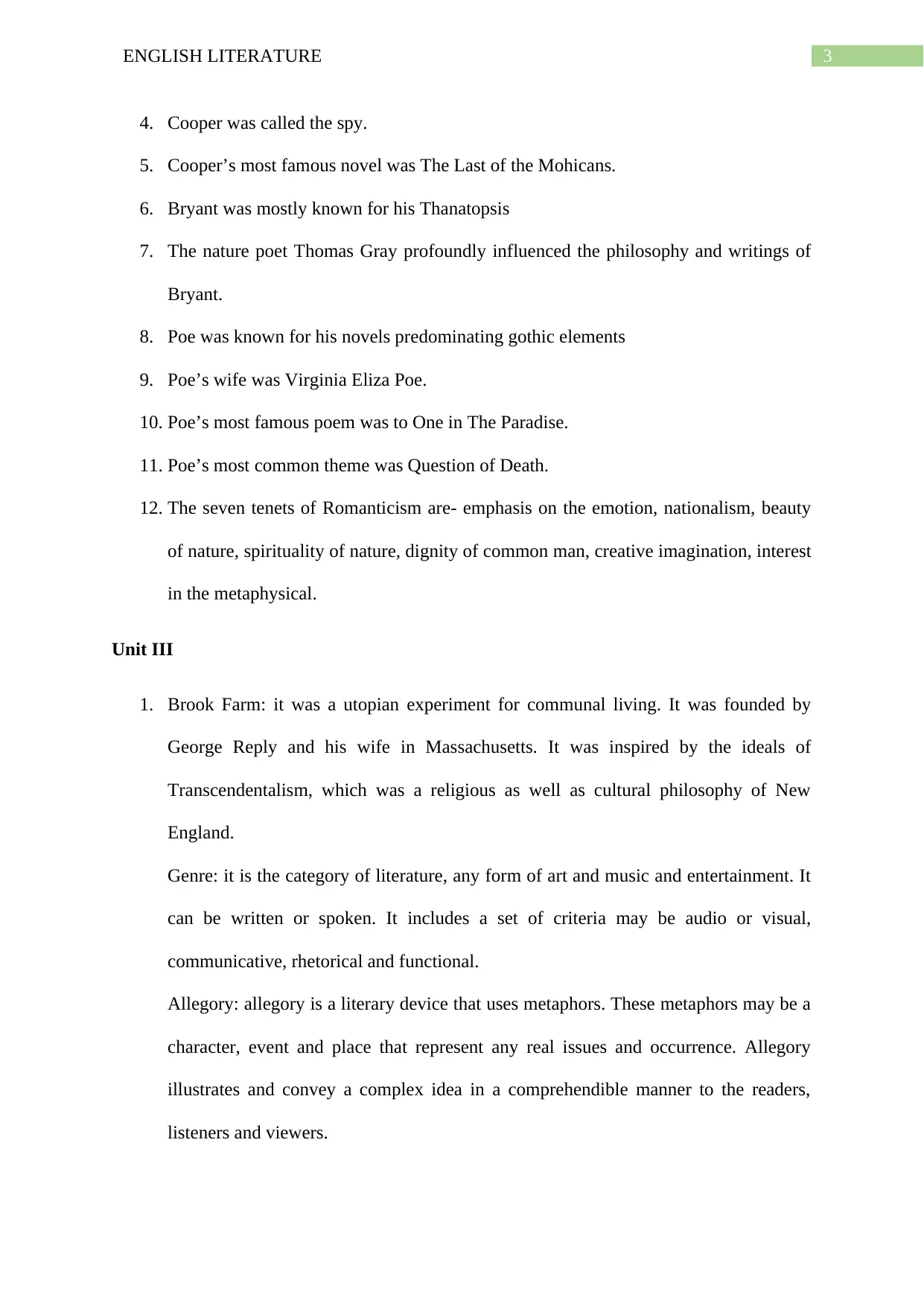
3ENGLISH LITERATURE
4. Cooper was called the spy.
5. Cooper’s most famous novel was The Last of the Mohicans.
6. Bryant was mostly known for his Thanatopsis
7. The nature poet Thomas Gray profoundly influenced the philosophy and writings of
Bryant.
8. Poe was known for his novels predominating gothic elements
9. Poe’s wife was Virginia Eliza Poe.
10. Poe’s most famous poem was to One in The Paradise.
11. Poe’s most common theme was Question of Death.
12. The seven tenets of Romanticism are- emphasis on the emotion, nationalism, beauty
of nature, spirituality of nature, dignity of common man, creative imagination, interest
in the metaphysical.
Unit III
1. Brook Farm: it was a utopian experiment for communal living. It was founded by
George Reply and his wife in Massachusetts. It was inspired by the ideals of
Transcendentalism, which was a religious as well as cultural philosophy of New
England.
Genre: it is the category of literature, any form of art and music and entertainment. It
can be written or spoken. It includes a set of criteria may be audio or visual,
communicative, rhetorical and functional.
Allegory: allegory is a literary device that uses metaphors. These metaphors may be a
character, event and place that represent any real issues and occurrence. Allegory
illustrates and convey a complex idea in a comprehendible manner to the readers,
listeners and viewers.
4. Cooper was called the spy.
5. Cooper’s most famous novel was The Last of the Mohicans.
6. Bryant was mostly known for his Thanatopsis
7. The nature poet Thomas Gray profoundly influenced the philosophy and writings of
Bryant.
8. Poe was known for his novels predominating gothic elements
9. Poe’s wife was Virginia Eliza Poe.
10. Poe’s most famous poem was to One in The Paradise.
11. Poe’s most common theme was Question of Death.
12. The seven tenets of Romanticism are- emphasis on the emotion, nationalism, beauty
of nature, spirituality of nature, dignity of common man, creative imagination, interest
in the metaphysical.
Unit III
1. Brook Farm: it was a utopian experiment for communal living. It was founded by
George Reply and his wife in Massachusetts. It was inspired by the ideals of
Transcendentalism, which was a religious as well as cultural philosophy of New
England.
Genre: it is the category of literature, any form of art and music and entertainment. It
can be written or spoken. It includes a set of criteria may be audio or visual,
communicative, rhetorical and functional.
Allegory: allegory is a literary device that uses metaphors. These metaphors may be a
character, event and place that represent any real issues and occurrence. Allegory
illustrates and convey a complex idea in a comprehendible manner to the readers,
listeners and viewers.
Paraphrase This Document
Need a fresh take? Get an instant paraphrase of this document with our AI Paraphraser
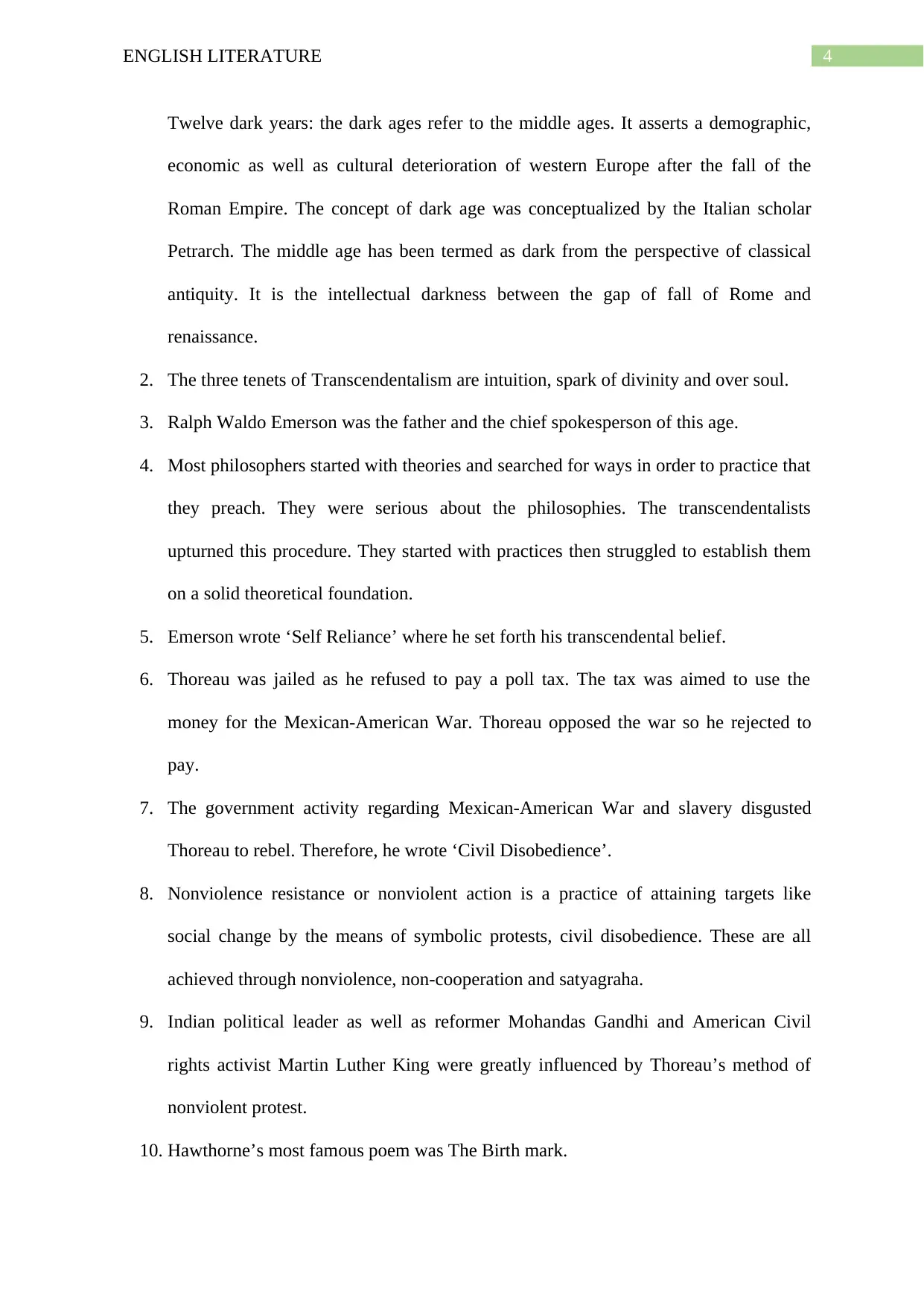
4ENGLISH LITERATURE
Twelve dark years: the dark ages refer to the middle ages. It asserts a demographic,
economic as well as cultural deterioration of western Europe after the fall of the
Roman Empire. The concept of dark age was conceptualized by the Italian scholar
Petrarch. The middle age has been termed as dark from the perspective of classical
antiquity. It is the intellectual darkness between the gap of fall of Rome and
renaissance.
2. The three tenets of Transcendentalism are intuition, spark of divinity and over soul.
3. Ralph Waldo Emerson was the father and the chief spokesperson of this age.
4. Most philosophers started with theories and searched for ways in order to practice that
they preach. They were serious about the philosophies. The transcendentalists
upturned this procedure. They started with practices then struggled to establish them
on a solid theoretical foundation.
5. Emerson wrote ‘Self Reliance’ where he set forth his transcendental belief.
6. Thoreau was jailed as he refused to pay a poll tax. The tax was aimed to use the
money for the Mexican-American War. Thoreau opposed the war so he rejected to
pay.
7. The government activity regarding Mexican-American War and slavery disgusted
Thoreau to rebel. Therefore, he wrote ‘Civil Disobedience’.
8. Nonviolence resistance or nonviolent action is a practice of attaining targets like
social change by the means of symbolic protests, civil disobedience. These are all
achieved through nonviolence, non-cooperation and satyagraha.
9. Indian political leader as well as reformer Mohandas Gandhi and American Civil
rights activist Martin Luther King were greatly influenced by Thoreau’s method of
nonviolent protest.
10. Hawthorne’s most famous poem was The Birth mark.
Twelve dark years: the dark ages refer to the middle ages. It asserts a demographic,
economic as well as cultural deterioration of western Europe after the fall of the
Roman Empire. The concept of dark age was conceptualized by the Italian scholar
Petrarch. The middle age has been termed as dark from the perspective of classical
antiquity. It is the intellectual darkness between the gap of fall of Rome and
renaissance.
2. The three tenets of Transcendentalism are intuition, spark of divinity and over soul.
3. Ralph Waldo Emerson was the father and the chief spokesperson of this age.
4. Most philosophers started with theories and searched for ways in order to practice that
they preach. They were serious about the philosophies. The transcendentalists
upturned this procedure. They started with practices then struggled to establish them
on a solid theoretical foundation.
5. Emerson wrote ‘Self Reliance’ where he set forth his transcendental belief.
6. Thoreau was jailed as he refused to pay a poll tax. The tax was aimed to use the
money for the Mexican-American War. Thoreau opposed the war so he rejected to
pay.
7. The government activity regarding Mexican-American War and slavery disgusted
Thoreau to rebel. Therefore, he wrote ‘Civil Disobedience’.
8. Nonviolence resistance or nonviolent action is a practice of attaining targets like
social change by the means of symbolic protests, civil disobedience. These are all
achieved through nonviolence, non-cooperation and satyagraha.
9. Indian political leader as well as reformer Mohandas Gandhi and American Civil
rights activist Martin Luther King were greatly influenced by Thoreau’s method of
nonviolent protest.
10. Hawthorne’s most famous poem was The Birth mark.
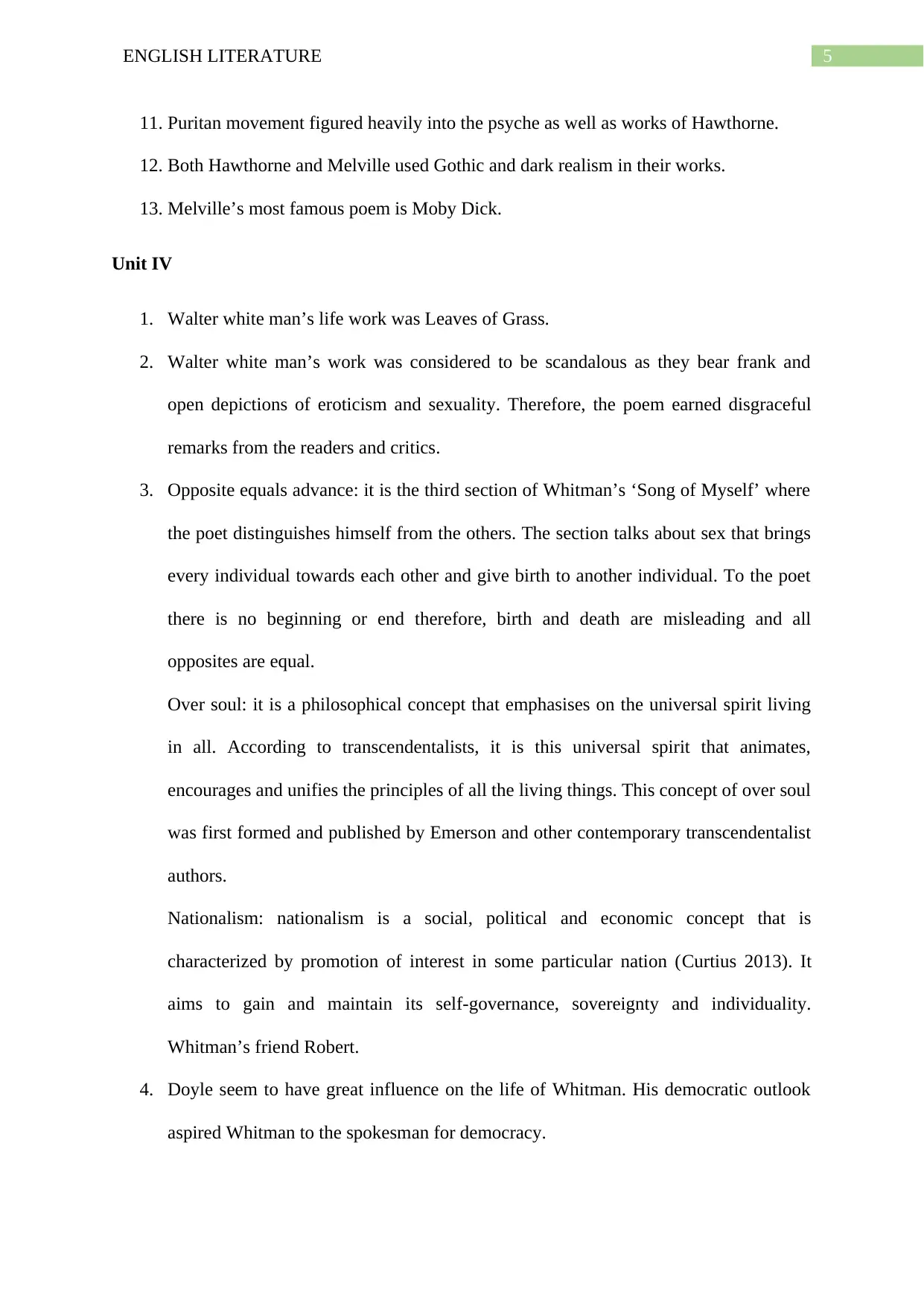
5ENGLISH LITERATURE
11. Puritan movement figured heavily into the psyche as well as works of Hawthorne.
12. Both Hawthorne and Melville used Gothic and dark realism in their works.
13. Melville’s most famous poem is Moby Dick.
Unit IV
1. Walter white man’s life work was Leaves of Grass.
2. Walter white man’s work was considered to be scandalous as they bear frank and
open depictions of eroticism and sexuality. Therefore, the poem earned disgraceful
remarks from the readers and critics.
3. Opposite equals advance: it is the third section of Whitman’s ‘Song of Myself’ where
the poet distinguishes himself from the others. The section talks about sex that brings
every individual towards each other and give birth to another individual. To the poet
there is no beginning or end therefore, birth and death are misleading and all
opposites are equal.
Over soul: it is a philosophical concept that emphasises on the universal spirit living
in all. According to transcendentalists, it is this universal spirit that animates,
encourages and unifies the principles of all the living things. This concept of over soul
was first formed and published by Emerson and other contemporary transcendentalist
authors.
Nationalism: nationalism is a social, political and economic concept that is
characterized by promotion of interest in some particular nation (Curtius 2013). It
aims to gain and maintain its self-governance, sovereignty and individuality.
Whitman’s friend Robert.
4. Doyle seem to have great influence on the life of Whitman. His democratic outlook
aspired Whitman to the spokesman for democracy.
11. Puritan movement figured heavily into the psyche as well as works of Hawthorne.
12. Both Hawthorne and Melville used Gothic and dark realism in their works.
13. Melville’s most famous poem is Moby Dick.
Unit IV
1. Walter white man’s life work was Leaves of Grass.
2. Walter white man’s work was considered to be scandalous as they bear frank and
open depictions of eroticism and sexuality. Therefore, the poem earned disgraceful
remarks from the readers and critics.
3. Opposite equals advance: it is the third section of Whitman’s ‘Song of Myself’ where
the poet distinguishes himself from the others. The section talks about sex that brings
every individual towards each other and give birth to another individual. To the poet
there is no beginning or end therefore, birth and death are misleading and all
opposites are equal.
Over soul: it is a philosophical concept that emphasises on the universal spirit living
in all. According to transcendentalists, it is this universal spirit that animates,
encourages and unifies the principles of all the living things. This concept of over soul
was first formed and published by Emerson and other contemporary transcendentalist
authors.
Nationalism: nationalism is a social, political and economic concept that is
characterized by promotion of interest in some particular nation (Curtius 2013). It
aims to gain and maintain its self-governance, sovereignty and individuality.
Whitman’s friend Robert.
4. Doyle seem to have great influence on the life of Whitman. His democratic outlook
aspired Whitman to the spokesman for democracy.
⊘ This is a preview!⊘
Do you want full access?
Subscribe today to unlock all pages.

Trusted by 1+ million students worldwide
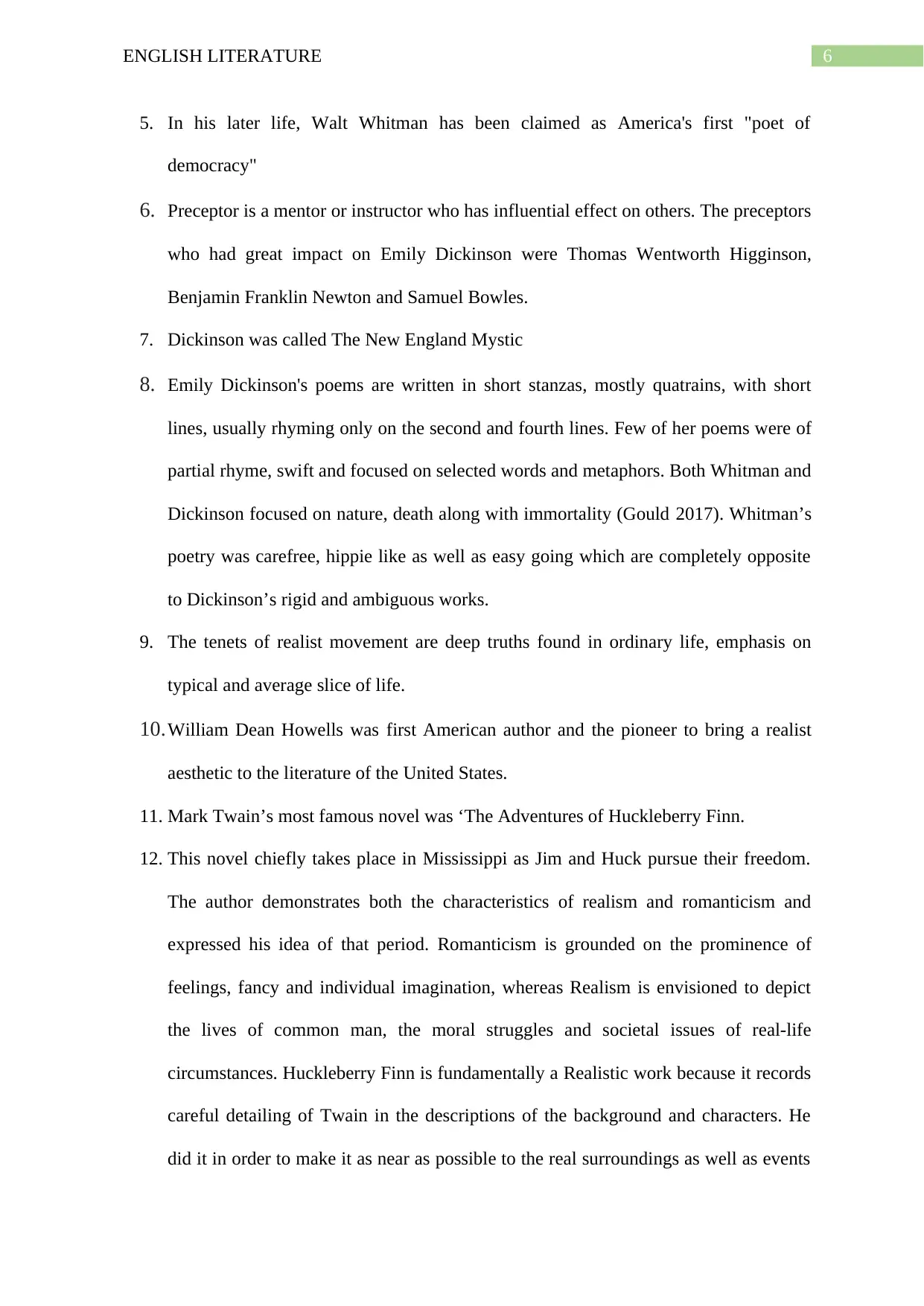
6ENGLISH LITERATURE
5. In his later life, Walt Whitman has been claimed as America's first "poet of
democracy"
6. Preceptor is a mentor or instructor who has influential effect on others. The preceptors
who had great impact on Emily Dickinson were Thomas Wentworth Higginson,
Benjamin Franklin Newton and Samuel Bowles.
7. Dickinson was called The New England Mystic
8. Emily Dickinson's poems are written in short stanzas, mostly quatrains, with short
lines, usually rhyming only on the second and fourth lines. Few of her poems were of
partial rhyme, swift and focused on selected words and metaphors. Both Whitman and
Dickinson focused on nature, death along with immortality (Gould 2017). Whitman’s
poetry was carefree, hippie like as well as easy going which are completely opposite
to Dickinson’s rigid and ambiguous works.
9. The tenets of realist movement are deep truths found in ordinary life, emphasis on
typical and average slice of life.
10.William Dean Howells was first American author and the pioneer to bring a realist
aesthetic to the literature of the United States.
11. Mark Twain’s most famous novel was ‘The Adventures of Huckleberry Finn.
12. This novel chiefly takes place in Mississippi as Jim and Huck pursue their freedom.
The author demonstrates both the characteristics of realism and romanticism and
expressed his idea of that period. Romanticism is grounded on the prominence of
feelings, fancy and individual imagination, whereas Realism is envisioned to depict
the lives of common man, the moral struggles and societal issues of real-life
circumstances. Huckleberry Finn is fundamentally a Realistic work because it records
careful detailing of Twain in the descriptions of the background and characters. He
did it in order to make it as near as possible to the real surroundings as well as events
5. In his later life, Walt Whitman has been claimed as America's first "poet of
democracy"
6. Preceptor is a mentor or instructor who has influential effect on others. The preceptors
who had great impact on Emily Dickinson were Thomas Wentworth Higginson,
Benjamin Franklin Newton and Samuel Bowles.
7. Dickinson was called The New England Mystic
8. Emily Dickinson's poems are written in short stanzas, mostly quatrains, with short
lines, usually rhyming only on the second and fourth lines. Few of her poems were of
partial rhyme, swift and focused on selected words and metaphors. Both Whitman and
Dickinson focused on nature, death along with immortality (Gould 2017). Whitman’s
poetry was carefree, hippie like as well as easy going which are completely opposite
to Dickinson’s rigid and ambiguous works.
9. The tenets of realist movement are deep truths found in ordinary life, emphasis on
typical and average slice of life.
10.William Dean Howells was first American author and the pioneer to bring a realist
aesthetic to the literature of the United States.
11. Mark Twain’s most famous novel was ‘The Adventures of Huckleberry Finn.
12. This novel chiefly takes place in Mississippi as Jim and Huck pursue their freedom.
The author demonstrates both the characteristics of realism and romanticism and
expressed his idea of that period. Romanticism is grounded on the prominence of
feelings, fancy and individual imagination, whereas Realism is envisioned to depict
the lives of common man, the moral struggles and societal issues of real-life
circumstances. Huckleberry Finn is fundamentally a Realistic work because it records
careful detailing of Twain in the descriptions of the background and characters. He
did it in order to make it as near as possible to the real surroundings as well as events
Paraphrase This Document
Need a fresh take? Get an instant paraphrase of this document with our AI Paraphraser
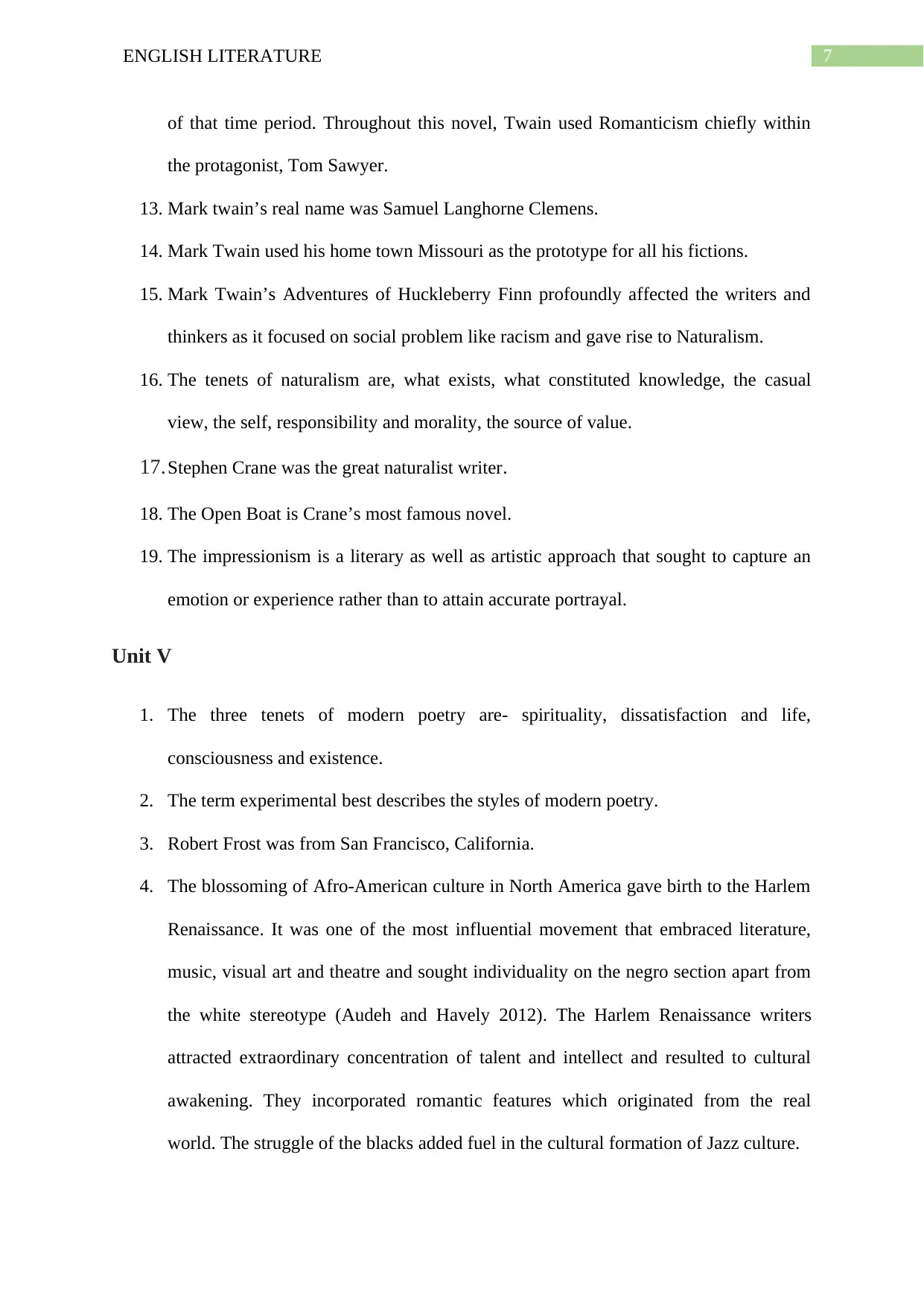
7ENGLISH LITERATURE
of that time period. Throughout this novel, Twain used Romanticism chiefly within
the protagonist, Tom Sawyer.
13. Mark twain’s real name was Samuel Langhorne Clemens.
14. Mark Twain used his home town Missouri as the prototype for all his fictions.
15. Mark Twain’s Adventures of Huckleberry Finn profoundly affected the writers and
thinkers as it focused on social problem like racism and gave rise to Naturalism.
16. The tenets of naturalism are, what exists, what constituted knowledge, the casual
view, the self, responsibility and morality, the source of value.
17.Stephen Crane was the great naturalist writer.
18. The Open Boat is Crane’s most famous novel.
19. The impressionism is a literary as well as artistic approach that sought to capture an
emotion or experience rather than to attain accurate portrayal.
Unit V
1. The three tenets of modern poetry are- spirituality, dissatisfaction and life,
consciousness and existence.
2. The term experimental best describes the styles of modern poetry.
3. Robert Frost was from San Francisco, California.
4. The blossoming of Afro-American culture in North America gave birth to the Harlem
Renaissance. It was one of the most influential movement that embraced literature,
music, visual art and theatre and sought individuality on the negro section apart from
the white stereotype (Audeh and Havely 2012). The Harlem Renaissance writers
attracted extraordinary concentration of talent and intellect and resulted to cultural
awakening. They incorporated romantic features which originated from the real
world. The struggle of the blacks added fuel in the cultural formation of Jazz culture.
of that time period. Throughout this novel, Twain used Romanticism chiefly within
the protagonist, Tom Sawyer.
13. Mark twain’s real name was Samuel Langhorne Clemens.
14. Mark Twain used his home town Missouri as the prototype for all his fictions.
15. Mark Twain’s Adventures of Huckleberry Finn profoundly affected the writers and
thinkers as it focused on social problem like racism and gave rise to Naturalism.
16. The tenets of naturalism are, what exists, what constituted knowledge, the casual
view, the self, responsibility and morality, the source of value.
17.Stephen Crane was the great naturalist writer.
18. The Open Boat is Crane’s most famous novel.
19. The impressionism is a literary as well as artistic approach that sought to capture an
emotion or experience rather than to attain accurate portrayal.
Unit V
1. The three tenets of modern poetry are- spirituality, dissatisfaction and life,
consciousness and existence.
2. The term experimental best describes the styles of modern poetry.
3. Robert Frost was from San Francisco, California.
4. The blossoming of Afro-American culture in North America gave birth to the Harlem
Renaissance. It was one of the most influential movement that embraced literature,
music, visual art and theatre and sought individuality on the negro section apart from
the white stereotype (Audeh and Havely 2012). The Harlem Renaissance writers
attracted extraordinary concentration of talent and intellect and resulted to cultural
awakening. They incorporated romantic features which originated from the real
world. The struggle of the blacks added fuel in the cultural formation of Jazz culture.
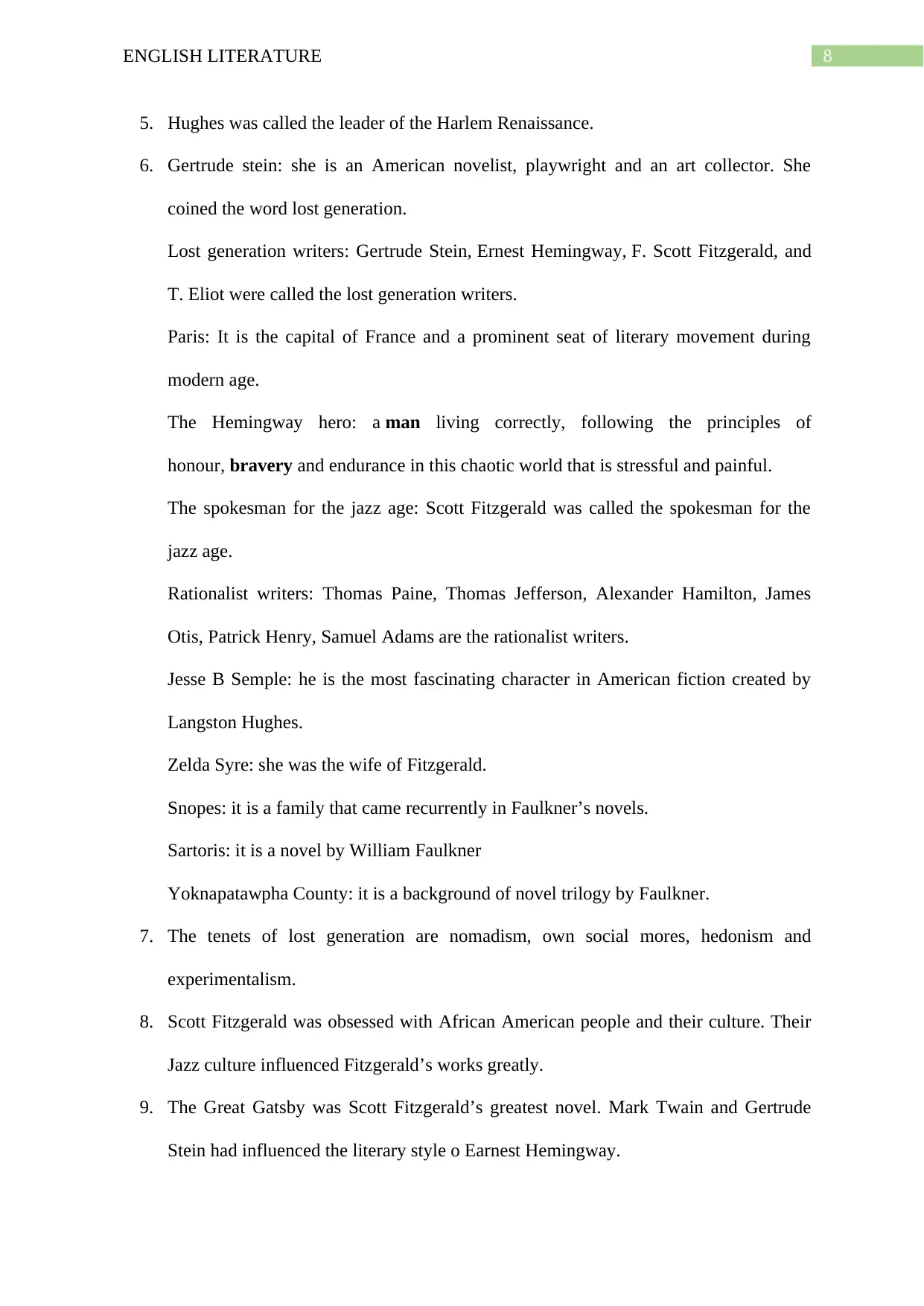
8ENGLISH LITERATURE
5. Hughes was called the leader of the Harlem Renaissance.
6. Gertrude stein: she is an American novelist, playwright and an art collector. She
coined the word lost generation.
Lost generation writers: Gertrude Stein, Ernest Hemingway, F. Scott Fitzgerald, and
T. Eliot were called the lost generation writers.
Paris: It is the capital of France and a prominent seat of literary movement during
modern age.
The Hemingway hero: a man living correctly, following the principles of
honour, bravery and endurance in this chaotic world that is stressful and painful.
The spokesman for the jazz age: Scott Fitzgerald was called the spokesman for the
jazz age.
Rationalist writers: Thomas Paine, Thomas Jefferson, Alexander Hamilton, James
Otis, Patrick Henry, Samuel Adams are the rationalist writers.
Jesse B Semple: he is the most fascinating character in American fiction created by
Langston Hughes.
Zelda Syre: she was the wife of Fitzgerald.
Snopes: it is a family that came recurrently in Faulkner’s novels.
Sartoris: it is a novel by William Faulkner
Yoknapatawpha County: it is a background of novel trilogy by Faulkner.
7. The tenets of lost generation are nomadism, own social mores, hedonism and
experimentalism.
8. Scott Fitzgerald was obsessed with African American people and their culture. Their
Jazz culture influenced Fitzgerald’s works greatly.
9. The Great Gatsby was Scott Fitzgerald’s greatest novel. Mark Twain and Gertrude
Stein had influenced the literary style o Earnest Hemingway.
5. Hughes was called the leader of the Harlem Renaissance.
6. Gertrude stein: she is an American novelist, playwright and an art collector. She
coined the word lost generation.
Lost generation writers: Gertrude Stein, Ernest Hemingway, F. Scott Fitzgerald, and
T. Eliot were called the lost generation writers.
Paris: It is the capital of France and a prominent seat of literary movement during
modern age.
The Hemingway hero: a man living correctly, following the principles of
honour, bravery and endurance in this chaotic world that is stressful and painful.
The spokesman for the jazz age: Scott Fitzgerald was called the spokesman for the
jazz age.
Rationalist writers: Thomas Paine, Thomas Jefferson, Alexander Hamilton, James
Otis, Patrick Henry, Samuel Adams are the rationalist writers.
Jesse B Semple: he is the most fascinating character in American fiction created by
Langston Hughes.
Zelda Syre: she was the wife of Fitzgerald.
Snopes: it is a family that came recurrently in Faulkner’s novels.
Sartoris: it is a novel by William Faulkner
Yoknapatawpha County: it is a background of novel trilogy by Faulkner.
7. The tenets of lost generation are nomadism, own social mores, hedonism and
experimentalism.
8. Scott Fitzgerald was obsessed with African American people and their culture. Their
Jazz culture influenced Fitzgerald’s works greatly.
9. The Great Gatsby was Scott Fitzgerald’s greatest novel. Mark Twain and Gertrude
Stein had influenced the literary style o Earnest Hemingway.
⊘ This is a preview!⊘
Do you want full access?
Subscribe today to unlock all pages.

Trusted by 1+ million students worldwide
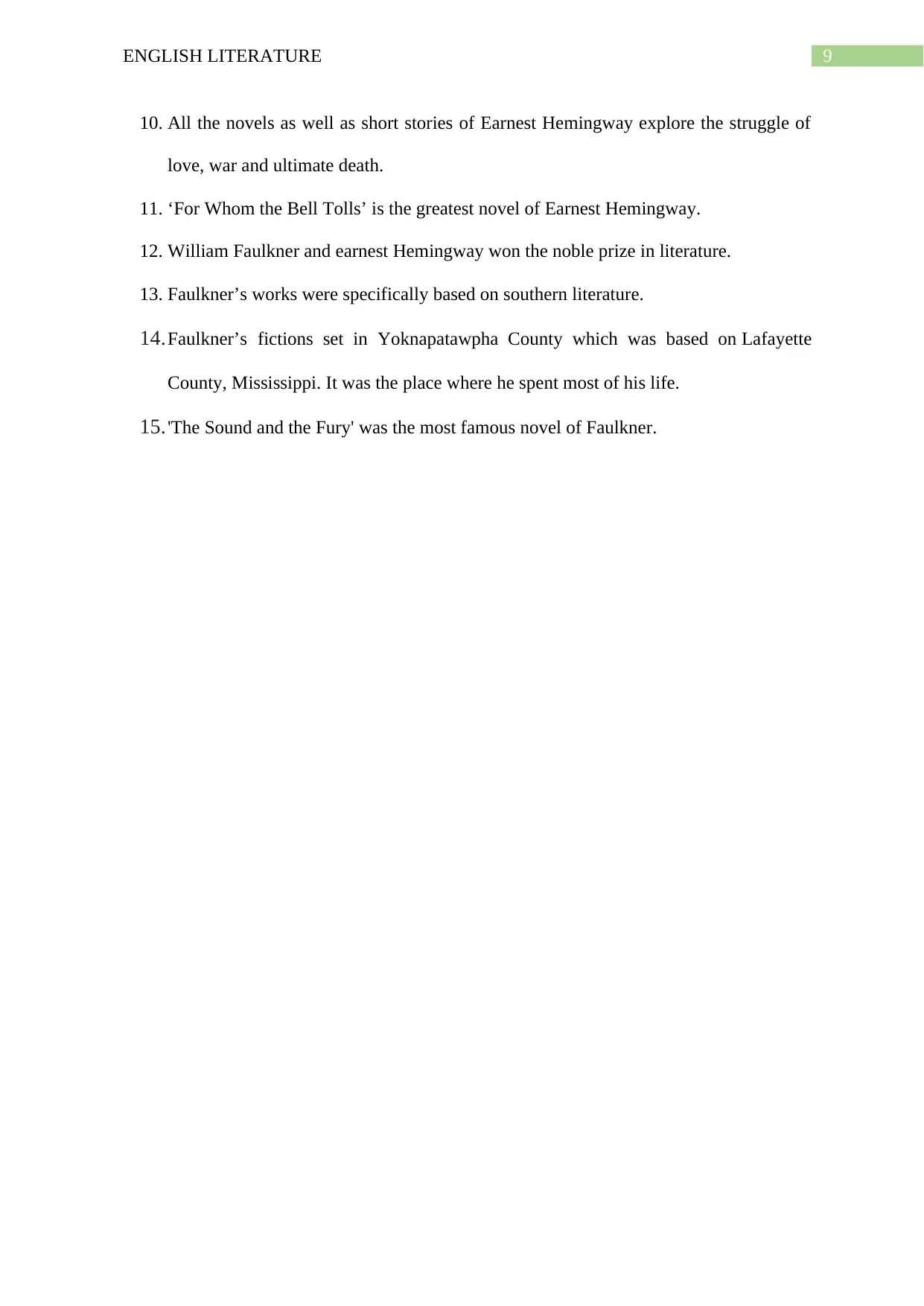
9ENGLISH LITERATURE
10. All the novels as well as short stories of Earnest Hemingway explore the struggle of
love, war and ultimate death.
11. ‘For Whom the Bell Tolls’ is the greatest novel of Earnest Hemingway.
12. William Faulkner and earnest Hemingway won the noble prize in literature.
13. Faulkner’s works were specifically based on southern literature.
14.Faulkner’s fictions set in Yoknapatawpha County which was based on Lafayette
County, Mississippi. It was the place where he spent most of his life.
15.'The Sound and the Fury' was the most famous novel of Faulkner.
10. All the novels as well as short stories of Earnest Hemingway explore the struggle of
love, war and ultimate death.
11. ‘For Whom the Bell Tolls’ is the greatest novel of Earnest Hemingway.
12. William Faulkner and earnest Hemingway won the noble prize in literature.
13. Faulkner’s works were specifically based on southern literature.
14.Faulkner’s fictions set in Yoknapatawpha County which was based on Lafayette
County, Mississippi. It was the place where he spent most of his life.
15.'The Sound and the Fury' was the most famous novel of Faulkner.
Paraphrase This Document
Need a fresh take? Get an instant paraphrase of this document with our AI Paraphraser
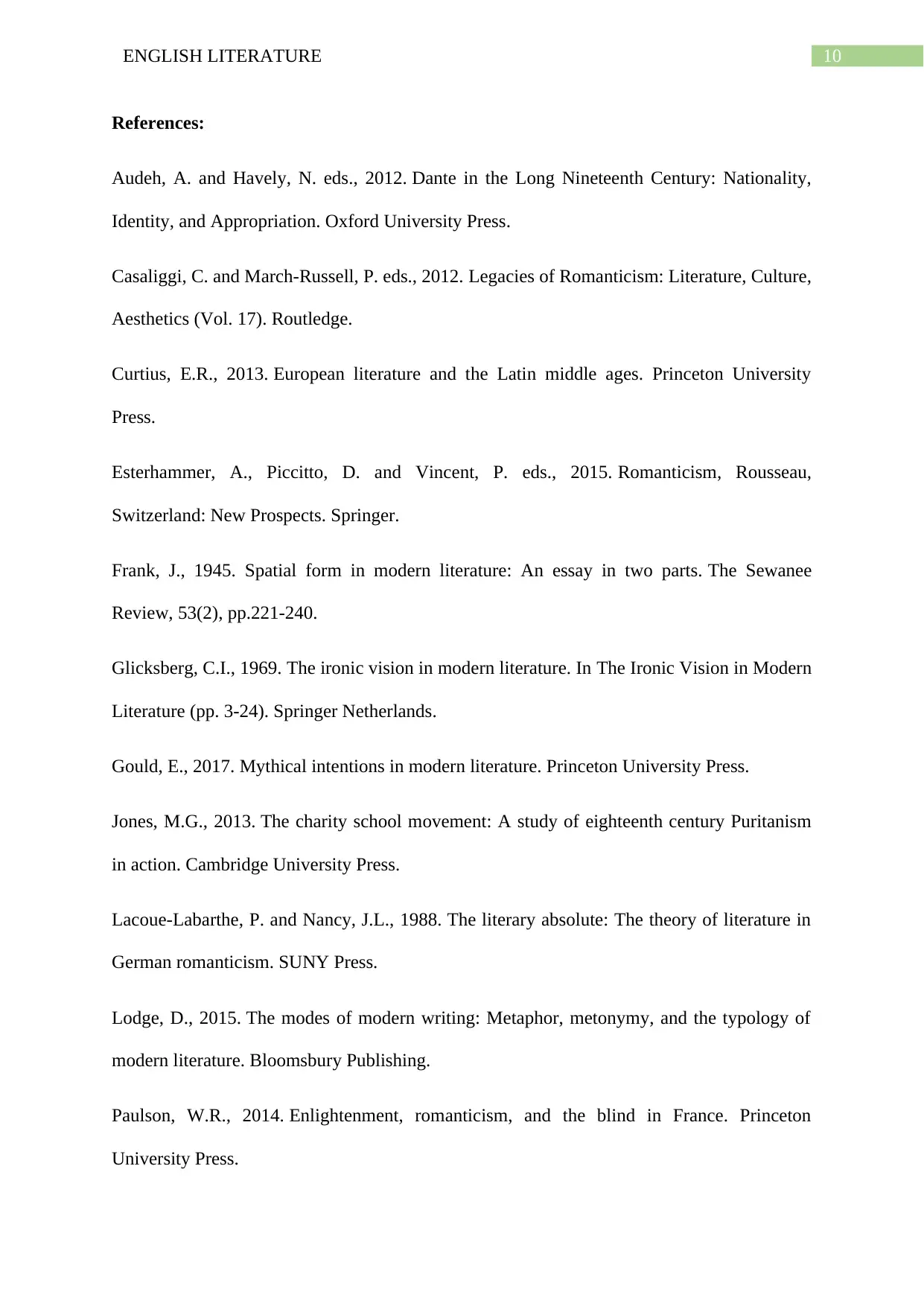
10ENGLISH LITERATURE
References:
Audeh, A. and Havely, N. eds., 2012. Dante in the Long Nineteenth Century: Nationality,
Identity, and Appropriation. Oxford University Press.
Casaliggi, C. and March-Russell, P. eds., 2012. Legacies of Romanticism: Literature, Culture,
Aesthetics (Vol. 17). Routledge.
Curtius, E.R., 2013. European literature and the Latin middle ages. Princeton University
Press.
Esterhammer, A., Piccitto, D. and Vincent, P. eds., 2015. Romanticism, Rousseau,
Switzerland: New Prospects. Springer.
Frank, J., 1945. Spatial form in modern literature: An essay in two parts. The Sewanee
Review, 53(2), pp.221-240.
Glicksberg, C.I., 1969. The ironic vision in modern literature. In The Ironic Vision in Modern
Literature (pp. 3-24). Springer Netherlands.
Gould, E., 2017. Mythical intentions in modern literature. Princeton University Press.
Jones, M.G., 2013. The charity school movement: A study of eighteenth century Puritanism
in action. Cambridge University Press.
Lacoue-Labarthe, P. and Nancy, J.L., 1988. The literary absolute: The theory of literature in
German romanticism. SUNY Press.
Lodge, D., 2015. The modes of modern writing: Metaphor, metonymy, and the typology of
modern literature. Bloomsbury Publishing.
Paulson, W.R., 2014. Enlightenment, romanticism, and the blind in France. Princeton
University Press.
References:
Audeh, A. and Havely, N. eds., 2012. Dante in the Long Nineteenth Century: Nationality,
Identity, and Appropriation. Oxford University Press.
Casaliggi, C. and March-Russell, P. eds., 2012. Legacies of Romanticism: Literature, Culture,
Aesthetics (Vol. 17). Routledge.
Curtius, E.R., 2013. European literature and the Latin middle ages. Princeton University
Press.
Esterhammer, A., Piccitto, D. and Vincent, P. eds., 2015. Romanticism, Rousseau,
Switzerland: New Prospects. Springer.
Frank, J., 1945. Spatial form in modern literature: An essay in two parts. The Sewanee
Review, 53(2), pp.221-240.
Glicksberg, C.I., 1969. The ironic vision in modern literature. In The Ironic Vision in Modern
Literature (pp. 3-24). Springer Netherlands.
Gould, E., 2017. Mythical intentions in modern literature. Princeton University Press.
Jones, M.G., 2013. The charity school movement: A study of eighteenth century Puritanism
in action. Cambridge University Press.
Lacoue-Labarthe, P. and Nancy, J.L., 1988. The literary absolute: The theory of literature in
German romanticism. SUNY Press.
Lodge, D., 2015. The modes of modern writing: Metaphor, metonymy, and the typology of
modern literature. Bloomsbury Publishing.
Paulson, W.R., 2014. Enlightenment, romanticism, and the blind in France. Princeton
University Press.
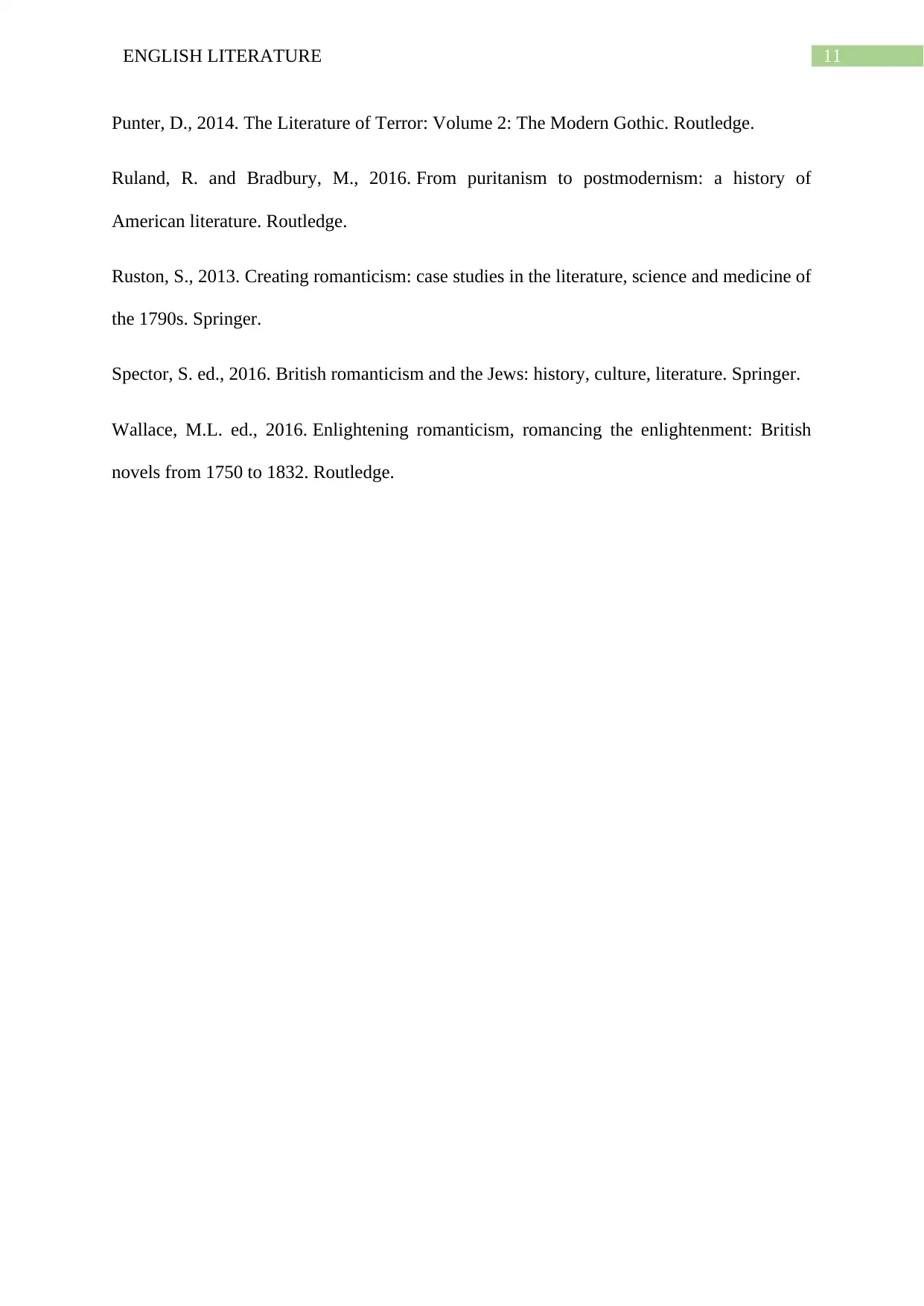
11ENGLISH LITERATURE
Punter, D., 2014. The Literature of Terror: Volume 2: The Modern Gothic. Routledge.
Ruland, R. and Bradbury, M., 2016. From puritanism to postmodernism: a history of
American literature. Routledge.
Ruston, S., 2013. Creating romanticism: case studies in the literature, science and medicine of
the 1790s. Springer.
Spector, S. ed., 2016. British romanticism and the Jews: history, culture, literature. Springer.
Wallace, M.L. ed., 2016. Enlightening romanticism, romancing the enlightenment: British
novels from 1750 to 1832. Routledge.
Punter, D., 2014. The Literature of Terror: Volume 2: The Modern Gothic. Routledge.
Ruland, R. and Bradbury, M., 2016. From puritanism to postmodernism: a history of
American literature. Routledge.
Ruston, S., 2013. Creating romanticism: case studies in the literature, science and medicine of
the 1790s. Springer.
Spector, S. ed., 2016. British romanticism and the Jews: history, culture, literature. Springer.
Wallace, M.L. ed., 2016. Enlightening romanticism, romancing the enlightenment: British
novels from 1750 to 1832. Routledge.
⊘ This is a preview!⊘
Do you want full access?
Subscribe today to unlock all pages.

Trusted by 1+ million students worldwide
1 out of 12
Your All-in-One AI-Powered Toolkit for Academic Success.
+13062052269
info@desklib.com
Available 24*7 on WhatsApp / Email
![[object Object]](/_next/static/media/star-bottom.7253800d.svg)
Unlock your academic potential
Copyright © 2020–2025 A2Z Services. All Rights Reserved. Developed and managed by ZUCOL.